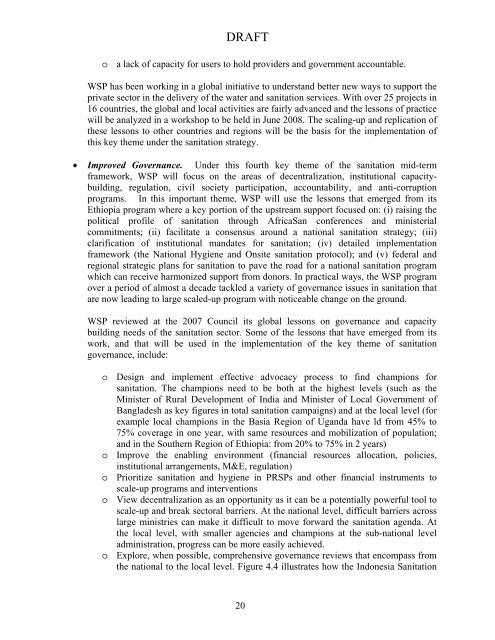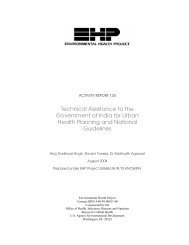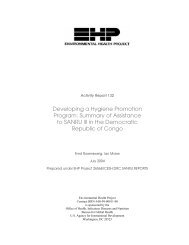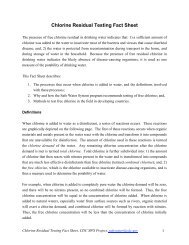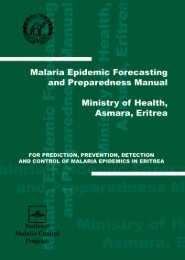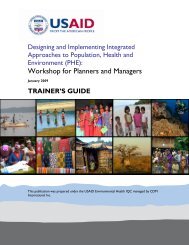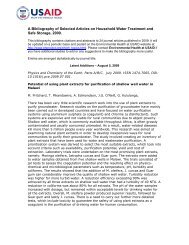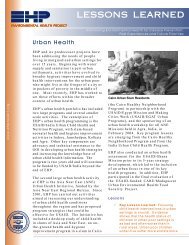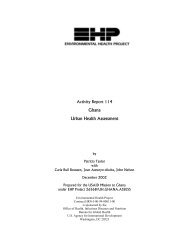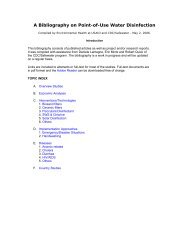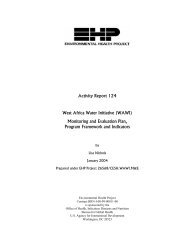The Water and Sanitation Program - Environmental Health at USAID
The Water and Sanitation Program - Environmental Health at USAID
The Water and Sanitation Program - Environmental Health at USAID
Create successful ePaper yourself
Turn your PDF publications into a flip-book with our unique Google optimized e-Paper software.
DRAFTo a lack of capacity for users to hold providers <strong>and</strong> government accountable.WSP has been working in a global initi<strong>at</strong>ive to underst<strong>and</strong> better new ways to support thepriv<strong>at</strong>e sector in the delivery of the w<strong>at</strong>er <strong>and</strong> sanit<strong>at</strong>ion services. With over 25 projects in16 countries, the global <strong>and</strong> local activities are fairly advanced <strong>and</strong> the lessons of practicewill be analyzed in a workshop to be held in June 2008. <strong>The</strong> scaling-up <strong>and</strong> replic<strong>at</strong>ion ofthese lessons to other countries <strong>and</strong> regions will be the basis for the implement<strong>at</strong>ion ofthis key theme under the sanit<strong>at</strong>ion str<strong>at</strong>egy.• Improved Governance. Under this fourth key theme of the sanit<strong>at</strong>ion mid-termframework, WSP will focus on the areas of decentraliz<strong>at</strong>ion, institutional capacitybuilding,regul<strong>at</strong>ion, civil society particip<strong>at</strong>ion, accountability, <strong>and</strong> anti-corruptionprograms. In this important theme, WSP will use the lessons th<strong>at</strong> emerged from itsEthiopia program where a key portion of the upstream support focused on: (i) raising thepolitical profile of sanit<strong>at</strong>ion through AfricaSan conferences <strong>and</strong> ministerialcommitments; (ii) facilit<strong>at</strong>e a consensus around a n<strong>at</strong>ional sanit<strong>at</strong>ion str<strong>at</strong>egy; (iii)clarific<strong>at</strong>ion of institutional m<strong>and</strong><strong>at</strong>es for sanit<strong>at</strong>ion; (iv) detailed implement<strong>at</strong>ionframework (the N<strong>at</strong>ional Hygiene <strong>and</strong> Onsite sanit<strong>at</strong>ion protocol); <strong>and</strong> (v) federal <strong>and</strong>regional str<strong>at</strong>egic plans for sanit<strong>at</strong>ion to pave the road for a n<strong>at</strong>ional sanit<strong>at</strong>ion programwhich can receive harmonized support from donors. In practical ways, the WSP programover a period of almost a decade tackled a variety of governance issues in sanit<strong>at</strong>ion th<strong>at</strong>are now leading to large scaled-up program with noticeable change on the ground.WSP reviewed <strong>at</strong> the 2007 Council its global lessons on governance <strong>and</strong> capacitybuilding needs of the sanit<strong>at</strong>ion sector. Some of the lessons th<strong>at</strong> have emerged from itswork, <strong>and</strong> th<strong>at</strong> will be used in the implement<strong>at</strong>ion of the key theme of sanit<strong>at</strong>iongovernance, include:o Design <strong>and</strong> implement effective advocacy process to find champions forsanit<strong>at</strong>ion. <strong>The</strong> champions need to be both <strong>at</strong> the highest levels (such as theMinister of Rural Development of India <strong>and</strong> Minister of Local Government ofBangladesh as key figures in total sanit<strong>at</strong>ion campaigns) <strong>and</strong> <strong>at</strong> the local level (forexample local champions in the Basia Region of Ug<strong>and</strong>a have ld from 45% to75% coverage in one year, with same resources <strong>and</strong> mobiliz<strong>at</strong>ion of popul<strong>at</strong>ion;<strong>and</strong> in the Southern Region of Ethiopia: from 20% to 75% in 2 years)o Improve the enabling environment (financial resources alloc<strong>at</strong>ion, policies,institutional arrangements, M&E, regul<strong>at</strong>ion)o Prioritize sanit<strong>at</strong>ion <strong>and</strong> hygiene in PRSPs <strong>and</strong> other financial instruments toscale-up programs <strong>and</strong> interventionso View decentraliz<strong>at</strong>ion as an opportunity as it can be a potentially powerful tool toscale-up <strong>and</strong> break sectoral barriers. At the n<strong>at</strong>ional level, difficult barriers acrosslarge ministries can make it difficult to move forward the sanit<strong>at</strong>ion agenda. Atthe local level, with smaller agencies <strong>and</strong> champions <strong>at</strong> the sub-n<strong>at</strong>ional leveladministr<strong>at</strong>ion, progress can be more easily achieved.o Explore, when possible, comprehensive governance reviews th<strong>at</strong> encompass fromthe n<strong>at</strong>ional to the local level. Figure 4.4 illustr<strong>at</strong>es how the Indonesia <strong>Sanit<strong>at</strong>ion</strong>20


